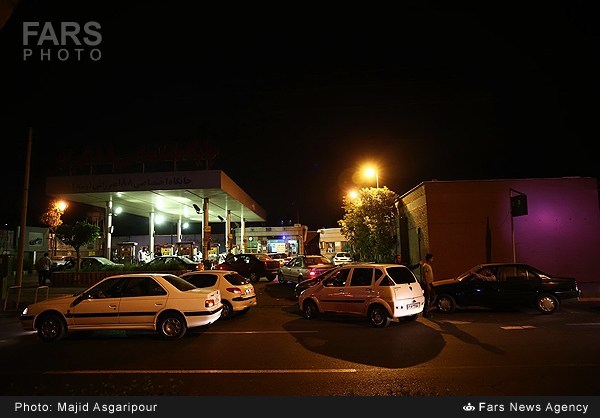Iranians woke this morning to subsidy cuts on gasoline. The first 60 liters of fuel cost 7,000 Rials (about $0.27) per liter, a rise of 75% from the previous level of 4,000 Rials ($0.15). Every liter after the 60-liter allowance costs 10,000 Rials ($0.39), up from 7,000 Rials.
Jason Rezaian writes in the Washington Post about the impact of the cuts, examining how the increase in gas prices “will test the patience of a public that has been waiting nearly a year for an economic recovery” since Hassan Rouhani’s election as President.
Gasoline prices in Iran have risen steadily and significantly in recent years, but at 22 cents per liter, they are still some of the cheapest in the world.
Although Iranians have traditionally adjusted quickly to higher costs without noticeably changing their consumption habits, a new increase will test the patience of a public that has been waiting nearly a year for an economic recovery that President Hassan Rouhani promised when he was elected in June. The new prices, announced by authorities in Tehran and going into effect at midnight, will be 10,000 rials per liter, with a ration of 60 liters at 7,000 rials.
Costs will remain low by global standards, but for citizens here, the skyrocketing price at the pump in relation to the value of their national currency, the rial, is shocking. When Iranians paid 800 rials in 2005, five-digit gasoline prices seemed unfathomable. But the new rate brings prices into that previously uncharted territory.
Bijan Haj Mohammad Reza, the head of Iran’s association of gas station operators, said Tuesday that digital readers at pumps are not equipped to display prices higher than 9,999 rials per liter. The current price is 7,000 rials. (The official exchange rate Wednesday was more than 25,530 rials to the U.S. dollar, and the open rate, at which the vast majority of transactions are conducted, was 33,000 rials to the dollar.)
Tehran’s currency market has responded to the uncertainty with a decline of more than 5 percent in the rial against the U.S. dollar this week in open rate trading.
Iran’s main car manufacturer, Iran Khodro, one of the country’s biggest employers, suspended sales until new fuel prices are announced, as the news would affect the auto giant’s pricing structure.
The increase at filling stations is another in a series of attempts by Rouhani’s administration to reduce subsidies and cut the wasteful spending that was costing the government more than $50 billion annually.
Rouhani’s administration made its biggest changes to the subsidy system this month, halting a cash grant program so authorities could review which Iranians were most in need of financial assistance.
None of the goods and services that the Islamic republic subsidizes, however, is as costly or sensitive as gasoline. Since Iran nationalized its oil industry in 1951, all successive governments have let citizens think that cheap gas was a birthright.
“In the past, we had a saying that to avoid trouble, Iran’s leaders shouldn’t play with people’s access to bread and tea. In modern times, we’ve said the same about gasoline. Raising the price on these products is always risky in Iran,” said Ardeshir Golami, a retired petrochemical engineer.
The population boom that followed Iran’s 1979 revolution, along with a domestic auto industry that made cheap cars available to tens of millions of Iranians, resulted in such a thirst for fuel that for the past two decades, Iran had to import most of its gasoline.
“Underpriced gasoline leads to overconsumption, when those subsidies could be used for more productive and healthier investments,” said Kevan Harris, a Princeton University sociologist who studies Iran’s social welfare system. “It also eats up one of Iran’s main exports for internal consumption.”
Iran’s government has often tinkered with its gasoline pricing structure, but not until recently have authorities planned to remove the subsidies completely, and they now realize that the process will take time.
“The government wants to increase its energy prices slowly. If we raise the price by 20 to 24 percent annually, in five years, the price will be completely liberalized,” Vice President Mohammad Shariatmadari said Monday. He said incremental price increases would lessen the blow of a probable spike in inflation.

